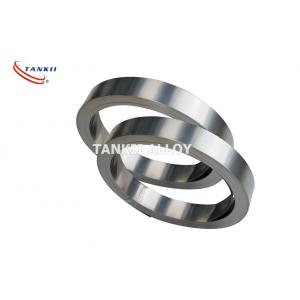

Add to Cart
4j29 Strip 0.15mm*20mm for Stamping Shell Metal Ceramic
(Common Name: Kovar, Nilo K, KV-1, Dilver Po, Vacon 12)
Alloy-4J29 also known as Kovar alloy. it was invented to meet the
need for a reliable glass-to-metal seal, which is required in
electronic devices such as light bulbs, vacuum tubes, cathode ray
tubes, and in vacuum systems in chemistry and other scientific
research. Most metals cannot seal to glass because their
coefficient of thermal expansion is not the same as glass, so as
the joint cools after fabrication the stresses due to the
differential expansion rates of the glass and metal cause the joint
to crack.
(-Kovar)
Kovar is a nickel-cobalt ferrous alloy compositionally identical to
Fernico, designed to be compatible with the thermal expansion
characteristics of borosilicate glass (~5 × 10?6 /K between 30 and
200 °C, to ~10 × 10?6 /K at 800 °C) in order to allow direct
mechanical connections over a range of temperatures. It finds
application in electroplated conductors entering glass envelopes of
electronic parts such as vacuum tubes (valves), X-ray and microwave
tubes and some lightbulbs.
The name Kovar is often used as a general term for Fe-Ni alloys
with these particular thermal expansion properties. Note the
related particular Fe-Ni alloy Invar which exhibits minimum thermal
expansion.
Alloy-4J29was invented to meet the need for a reliable
glass-to-metal seal, which is required in electronic devices such
as light bulbs, vacuum tubes, cathode ray tubes, and in vacuum
systems in chemistry and other scientific research. Most metals
cannot seal to glass because their coefficient of thermal expansion
is not the same as glass, so as the joint cools after fabrication
the stresses due to the differential expansion rates of the glass
and metal cause the joint to crack.
Alloy-4J29 not only has thermal expansion similar to glass, but its
nonlinear thermal expansion curve can often be made to match a
glass, thus allowing the joint to tolerate a wide temperature
range. Chemically, it bonds to glass via the intermediate oxide
layer of nickel oxide and cobalt oxide; the proportion of iron
oxide is low due to its reduction with cobalt. The bond strength is
highly dependent on the oxide layer thickness and character. The
presence of cobalt makes the oxide layer easier to melt and
dissolve in the molten glass. A grey, grey-blue or grey-brown color
indicates a good seal. A metallic color indicates lack of oxide,
while black color indicates overly oxidized metal, in both cases
leading to a weak joint.
Mainly used in electric vacuum components and emission control,
shock tube, igniting tube, glass magnetron, transistors, seal plug,
relay, integrated circuits lead, chassis, brackets and other
housing sealing.
Normal composition%
Ni | 28.5~29.5 | Fe | Bal. | Co | 16.8~17.8 | Si | ≤0.3 |
| Mo | ≤0.2 | Cu | ≤0.2 | Cr | ≤0.2 | Mn | ≤0.5 |
| C | ≤0.03 | P | ≤0.02 | S | ≤0.02 |
Tensile Strength, MPa
Code of condition | Condition | Wire | Strip |
| R | Soft | ≤585 | ≤570 |
| 1/4I | 1/4 Hard | 585~725 | 520~630 |
| 1/2I | 1/2 Hard | 655~795 | 590~700 |
| 3/4I | 3/4 Hard | 725~860 | 600~770 |
| I | Hard | ≥850 | ≥700 |
Typical Physical properties
Density (g/cm3) | 8.2 |
| Electrical resistivity at 20ºC(mm2/m) | 0.48 |
| Temperature factor of resistivity(20ºC~100ºC)X10-5/ºC | 3.7~3.9 |
| Curie point Tc/ ºC | 430 |
| Elastic Modulus, E/ Gpa | 138 |
Coefficient of expansion
| θ/ºC | α1/10-6ºC-1 | θ/ºC | α1/10-6ºC-1 |
| 20~60 | 7.8 | 20~500 | 6.2 |
| 20~100 | 6.4 | 20~550 | 7.1 |
| 20~200 | 5.9 | 20~600 | 7.8 |
| 20~300 | 5.3 | 20~700 | 9.2 |
| 20~400 | 5.1 | 20~800 | 10.2 |
| 20~450 | 5.3 | 20~900 | 11.4 |
Thermal conductivity
| θ/ºC | 100 | 200 | 300 | 400 | 500 |
| λ/ W/(m*ºC) | 20.6 | 21.5 | 22.7 | 23.7 | 25.4 |
| The heat treatment process | |
| Annealing for stress relief | Heated to 470~540ºC and hold 1~2 h. Cold down |
| annealing | In vacuum heated to 750~900ºC |
| Holding time | 14 min~1h. |
| Cooling rate | No more than 10 ºC/min cooled to 200 ºC |
